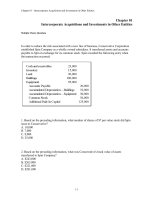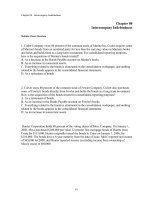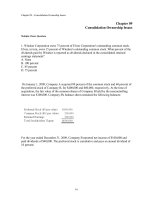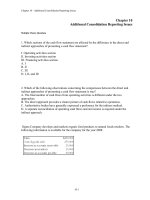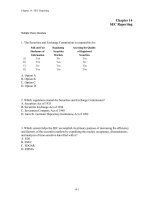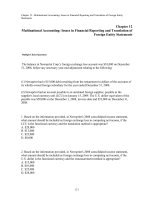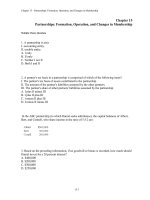Test bank advanced financial accounting ch 19 not for profit entities
Bạn đang xem bản rút gọn của tài liệu. Xem và tải ngay bản đầy đủ của tài liệu tại đây (431.77 KB, 82 trang )
Chapter 19 - Not-For-Profit Entities
Chapter 19
Not-For-Profit Entities
Multiple Choice Questions
1. Which rule-making body is currently setting standards of financial reporting for private
not-for-profit universities and for public (governmental) universities?
A. Option A
B. Option B
C. Option C
D. Option D
2. Net assets restricted as to time or purpose should be classified as:
I. temporarily restricted.
II. permanently restricted.
A. I only
B. II only
C. Both I and II
D. Neither I nor II
19-1
Chapter 19 - Not-For-Profit Entities
3. A not-for-profit organization received a donation temporarily restricted as to use. The
donated amount was later spent in accordance with the restriction. In which category(ies) of
net assets should the related revenues and expenses be recognized?
A. Option A
B. Option B
C. Option C
D. Option D
4. According to FASB 93, "Recognition of Depreciation by Not-For-Profit (NFP) Entities,"
NFP entities should recognize depreciation:
I. on all long-lived tangible assets.
II. on all long-lived intangible assets.
A. I only
B. II only
C. Both I and II
D. Neither I nor II
5. The term "restricted" as used in university accounting refers to a constraint on the use of
funds which has been:
I. internally imposed.
II. externally imposed.
A. I only
B. II only
C. Either I or II
D. Neither I nor II
19-2
Chapter 19 - Not-For-Profit Entities
6. According to Statement of Financial Accounting Standards 117, the statement of financial
position of a private university should report the excess of the university's assets over its
liabilities as:
A. fund balance.
B. unrestricted and restricted fund balance.
C. retained earnings.
D. unrestricted, temporarily restricted, and permanently restricted net assets.
7. Which of the following is an example of volunteer services received by a not-for-profit
entity that should be recognized as revenue?
I. Services requiring specialized skills, provided by individuals with those skills, that
otherwise would have to be purchased.
II. Services of lay faculty at a private university operated by a religious order.
III. Services that create or enhance non-financial assets, regardless of whether or not they
require specialized skills.
A. I only
B. I and III only
C. II and III only
D. I, II, and III
8. In a university, class cancellation refunds of tuition and fees should be recorded as:
I. a reduction of revenue from tuition and fees.
II. a reduction of accounts receivable.
A. I only
B. II only
C. Either I or II
D. Neither I nor II
19-3
Chapter 19 - Not-For-Profit Entities
9. Which of the following recognition and measurement bases best summarizes the usual
treatment of current contributions to private not-for-profit entities in accordance with FASB
116?
A. Option A
B. Option B
C. Option C
D. Option D
10. According to FASB 124, not-for-profit entities should report investments in the financial
statements at:
I. fair market value.
II. lower of cost or market.
A. I only
B. II only
C. Either I or II
D. Neither I nor II
11. Investment income for not-for-profit entities may include:
I. interest from debt investments.
II. dividends from equity investments.
III. changes in the fair values of both debt and equity investments.
A. I only
B. I and II only
C. I and III only
D. I, II, and III
19-4
Chapter 19 - Not-For-Profit Entities
12. A private university received $280,000 from student tuition and fees for the year 2009
summer session. The session began on June 20, 2009, and ended on July 30, 2009. The
university's fiscal year end is June 30. According to the AICPA College and University Audit
Guide, how should the university report the $280,000 of receipts in its financial statements for
the year ended June 30, 2009?
A. Current revenue of $280,000.
B. Current revenue of $70,000 and deferred revenue of $210,000.
C. Deferred revenue of $280,000.
D. Restricted current revenue of $280,000.
13. Assume that a private university collects tuition and fees at the beginning of summer
school, in which two weeks are offered in the first fiscal year and the remaining six weeks are
offered in the second fiscal year. According to the approach recommended by the National
Association of College and University Business Officers (NACUBO), the university would:
A. record the collections as a debit to Cash and a credit to Deferred Revenue for the entire
amount of the collections.
B. record the collections as a debit to Cash and a credit to Restricted current revenue for the
entire amount of the collections.
C. account for the entire tuition and fees as revenue in the first fiscal period.
D. recognize revenue in the first fiscal period for two-eighths of the tuition and fees and
record six-eighths of the collections as a deferred revenue.
14. A private university offers graduate assistantships to qualified students each year. In
exchange for the waiver of tuition, graduate assistants are required to assist faculty members
with research and other activities. Assume a graduate assistant received a $4,000 tuition
waiver for the current academic year. Based on these facts, the university should record
A. tuition revenues of $4,000 and expenditures of $4,000.
B. tuition revenues of $0 and expenditures of $0.
C. tuition revenues of $4,000 and expenditures of $0.
D. tuition revenues of $4,000 and a reduction of tuition revenues of $4,000.
19-5
Chapter 19 - Not-For-Profit Entities
15. For the year ended June 30, 2009, a university assessed its students a total of $4,000,000
for tuition and fees. Included in this amount was $300,000 of tuition remissions awarded to
graduate teaching assistants, and $150,000 of scholarships awarded to undergraduate students.
Tuition and fees totaling $3,550,000 were collected during the year ended June 30, 2009.
What amount should be reported in the unrestricted fund as net revenue from tuition and fees
for the year ended June 30, 2009?
A. $4,000,000
B. $3,550,000
C. $3,700,000
D. $3,850,000
16. A private not-for-profit university generally must depreciate all tangible fixed assets,
except:
I. works of art and other historical treasures.
II. administration buildings.
A. I only
B. II only
C. Both I and II
D. Neither I nor II
17. A private college received an offer from a CPA who is an alumnus to teach a onesemester advanced accounting course at no cost. FASB 116 prescribes that this contribution
of service:
A. need only be disclosed in the footnotes to the financial statements.
B. be recorded as an asset with an equivalent amount recorded in the unrestricted fund
balance.
C. be recorded as a revenue with an equivalent amount recorded as an expenditure.
D. need not be recorded if the service is for a period less than one academic year.
18. In accordance with FASB 117, contributions from donors which are to be permanently
invested should be disclosed on the statement of activities of a private university as an
increase in:
A. Permanently restricted net assets.
B. Permanently restricted fund balance.
C. Endowment fund balance.
D. Deferred revenues.
19-6
Chapter 19 - Not-For-Profit Entities
19. For the year ended June 30, 2009, a private college received contributions from alumni
which were restricted for faculty research stipends to be awarded during the next fiscal year.
For the year ended June 30, 2009, these contributions should be disclosed on the statement of
activities of the private college as an increase in:
A. the fund balance of the restricted current fund.
B. temporarily restricted net assets.
C. deferred revenues.
D. temporarily restricted fund balance.
20. A private, not-for-profit university should prepare which of the following financial
statements?
A. I, II, and III.
B. II, III, and IV.
C. I, II, and IV.
D. II, III, and V.
21. Unrestricted gifts and endowment income of a private university are reported as
A. increases in the unrestricted current fund balance on the statement of changes in fund
balances.
B. unrestricted revenues on the statement of current funds revenues, expenditures, and other
changes.
C. unrestricted revenues on the statement of activities.
D. increases in the unrestricted current fund balance on the statement of activities.
19-7
Chapter 19 - Not-For-Profit Entities
22. One of the major objectives of FASB 117 is to
A. emphasize the different fund structures that currently exist for all private, nonprofit
organizations.
B. change the reporting for governmental organizations so that their reporting is comparable
to that of private, nonprofit organizations.
C. report combined financial statements, instead of individual fund financial statements, for
all private, nonprofit organizations.
D. bring about greater uniformity in the financial statements of all private, not-for-profit
organizations.
23. A not-for-profit private college in Virginia created a separate foundation responsible for
obtaining financial support from alumni and others. Foundation assets are used for the benefit
of the college. Donations made to the foundation and subsequently transferred to the college
should be:
A. recognized as revenues by the foundation when received, and as revenues of the college
when transferred.
B. recognized as revenues by the foundation when received and as expenses by the foundation
when transferred.
C. recognized both as a change in its interest in the foundation and as revenues by the college
when the donation is received by the foundation.
D. recognized as an increase in net assets of the foundation and as revenues of the college
when the donation is received by the college.
24. FASB 93:
A. guides depreciation.
B. guides accounting for contributions.
C. establishes financial display requirements.
D. establishes the accounting for investments.
19-8
Chapter 19 - Not-For-Profit Entities
25. On the statement of operations prepared for a private, not-for-profit hospital, patient
service revenue earned during the year is reported net of amounts for which of the following
items?
I. Contractual adjustments
II. Bad debts expense
A. I only
B. II only
C. I and II
D. Neither I nor II
26. A private, not-for-profit hospital received a cash contribution of $100,000 from Samantha
Hicks on November 14, 2008. Ms. Hicks specified the money be used to acquire equipment.
On December 31, 2008, the hospital had not expended any of Ms. Hicks' contribution. On the
statement of changes in net assets for the year ended December 31, 2008, the hospital should
report the contribution as a $100,000 increase in
A. temporarily restricted net assets.
B. unrestricted net assets.
C. fund balance.
D. deferred revenue.
27. Unrestricted current funds of a private university designated by the governing board for a
specific future purpose should be reported as part of:
A. unrestricted net assets.
B. temporarily restricted net assets.
C. board-restricted net assets.
D. term endowments.
28. A private, not-for-profit geographic society received cash contributions which were
restricted by the donors for the acquisition of fixed assets. In which section of the statement of
cash flows would these cash contributions be reported?
A. Financing activities
B. Investing activities
C. Operating activities
D. Capital and related financing activities
19-9
Chapter 19 - Not-For-Profit Entities
29. On the statement of activities for a private, not-for-profit literary society, expenses
decrease which of the following classes of net assets?
I. temporarily restricted net assets
II. unrestricted net assets
A. I only
B. II only
C. Either I or II
D. Neither I nor II
30. Bridger Hospital, which is operated by a religious organization, provides charity care for
the indigent living in the region served by the hospital. How should Bridger report the amount
of its charity care on its financial statements?
A. In the notes to the financial statements only.
B. As unrestricted revenues on the statement of operations.
C. As net patient service revenue and as an expense, equal to the net patient service revenue,
on the statement of operations.
D. As temporarily restricted revenue on the statement of operations.
31. The governing board of Samaritan Hospital, which is operated by a religious organization,
designated $500,000 of cash for future expansion of the hospital. On the hospital's balance
sheet, the cash designated for future plant expansion would be disclosed in which of the
following classes of net assets?
A. Temporarily restricted net assets
B. Unrestricted net assets
C. Plant replacement and expansion.
D. Board designated net assets
32. Good Care Hospital, which is operated by a religious organization, received contributions
of $1,000,000 from donors who stipulated that the cash be used to construct an addition to the
hospital. As of the balance sheet date, none of the contributions had been expended for
construction. On the hospital's balance sheet, the cash contributions would be disclosed in
which of the following classes of net assets?
A. Temporarily restricted net assets
B. Donor restricted net assets
C. Assets whose use is limited
D. Permanently restricted net assets
19-10
Chapter 19 - Not-For-Profit Entities
33. A private, not-for-profit hospital received contributions of $50,000 from donors on June
15, 2009. The donors stipulated that their contributions be used to purchase equipment for the
hospital. As of June 30, 2009, the end of the hospital's fiscal year, $12,000 of the
contributions had been spent on equipment acquisitions. In the hospital's general fund, what
account would be credited to recognize the release of the restrictions on the temporarily
restricted contributions used to acquire equipment?
A. Revenue released from equipment acquisition restriction
B. Other financing sources
C. Net assets released from equipment acquisition restriction
D. Unrestricted net assets released from equipment acquisition restriction
34. A private, not-for-profit hospital uses a fund structure which includes a general fund and
donor restricted funds. The hospital's revenues from nursing programs and gift shops should
be accounted for in the:
A. specific purpose fund.
B. restricted current fund.
C. general fund.
D. time-restricted fund.
35. A private, not-for-profit hospital uses a fund structure which includes a general fund and
donor restricted funds. Contributions received from donors for research to be conducted by
the hospital should be accounted for in the:
A. specific purpose fund.
B. time-restricted fund.
C. general fund.
D. restricted current fund.
36. On June 30, 2009, a voluntary health and welfare organization received pledges from
donors amounting to $50,000. The donors did not place any time or use restrictions on the
amount pledged. It was estimated that 10 percent of the pledges would not be collected. How
should the voluntary health and welfare organization report these pledges on its financial
statements prepared at the end of its fiscal year, June 30, 2009?
A. As fund balance for $45,000.
B. As contribution revenue-unrestricted for $45,000.
C. As contribution revenue-unrestricted for $50,000.
D. As fund balance-unrestricted for $50,000.
19-11
Chapter 19 - Not-For-Profit Entities
37. The restricted funds of a not-for-profit hospital are often termed "______" funds because
they must hold the restricted assets and transfer expendable resources to the general fund for
expenditure.
A. specific
B. controlled
C. limited
D. holding
38. All restricted funds of private, not-for-profit hospitals account for resources:
A. whose use is restricted by the donor.
B. received and expended in the hospital's primary health care mission.
C. that are only temporarily restricted.
D. received or pledged by donors for use in future periods.
A donor agrees to contribute $5,000 per year at the end of each of the next five years to a
voluntary health and welfare organization. The donor did not place any use restrictions on the
amount pledged. The stream of the payments is discounted at 6 percent. The first payment of
$5,000 is received at the end of the first year. The present value factor for a five-payment
annuity due on June 30, 2009, at 6 percent is 4.2124.
39. Based on the preceding information, the journal entry to recognize present value at the
time the pledge is received includes:
A. a credit to Pledges Receivable—Temporarily Restricted for $25,000.
B. a debit to Contributions—Temporarily Restricted for $21,062.
C. a debit to Pledges Receivable—Temporarily Restricted for $21,062.
D. a credit to Contributions—Temporarily Restricted for $25,000.
40. Based on the preceding information, at the end of the first year, the pledge increased
unrestricted net assets by:
A. $25,000.
B. $21,062.
C. $4,212.
D. $5,000.
19-12
Chapter 19 - Not-For-Profit Entities
41. Based on the preceding information, the increase in present value of the contributions
receivable recognized at the end of the first year equals:
A. $5,000.
B. $1,264.
C. $4212.
D. $787.
42. A private, not-for-profit hospital received a donation of medicine from the XYZ
Pharmaceutical Company on March 15, 2009. The cost of the medicine to the company was
$66,000, and its market value was $110,000. Twenty percent of the medicine was used by the
hospital during the year ended June 30, 2009. On the hospital's statement of operations for the
year ended June 30, 2009, the contribution of medicine would increase operating revenues by
A. $66,000.
B. $110,000.
C. $52,800.
D. $88,000.
43. In accordance with FASB 116, contributions of services are recognized as increases in
unrestricted net assets by a private, not for profit entity if which of the following criteria are
satisfied?
I. The services received create or enhance nonfinancial assets.
II. The services require specialized skills, are provided by individuals possessing those skills,
and would typically need to be purchased if not provided by donations.
III. The services will be performed within the current fiscal year.
A. I or II.
B. I or III.
C. II or III.
D. I, II, III.
19-13
Chapter 19 - Not-For-Profit Entities
44. The disclosure, "net assets released from restrictions," is reported on which of the
following financial statements for a voluntary health and welfare organization?
I. The statement of cash flows.
II. The statement of activities.
A. I only
B. II only
C. Both I and II.
D. Neither I nor II.
45. Good Faith Hospital, operated by a religious organization, billed patients $4,000,000 for
services rendered during the year ended June 30, 2009. The hospital realized cash of
$3,500,000 from the patient billings because of the following reductions:
(1) contractual adjustments of $140,000 granted to private insurance companies and to the
federal government; and
(2) uncollectible accounts receivable of $360,000.
On the statement of operations prepared for the year ended June 30, 2009, Good Faith
Hospital should report net patient service revenue of:
A. $3,500,000.
B. $3,860,000.
C. $4,000,000.
D. $3,640,000.
46. During the fiscal year ended June 30, 2009, a private, not-for-profit hospital acquired
equipment costing $75,000, with cash contributed by donors who restricted their contributions
for this purpose. On the hospital's statement of cash flows for the year ended June 30, 2009,
the equipment acquisition should be reported in which of the following sections?
I. Operating activities
II. Financing activities
III. Investing activities
A. I
B. II
C. III
D. I, II, III
19-14
Chapter 19 - Not-For-Profit Entities
47. During the fiscal year ended June 30, 2009, Global Charities, a voluntary health and
welfare organization, received unrestricted cash contributions of $500,000 and temporarily
restricted cash contributions of $300,000. All of the temporarily restricted contributions were
restricted by the donors for equipment acquisitions. During the year ended June 30, 2009,
equipment costing $250,000 was acquired with the restricted contributions. As a result of
these two contributions, Global Charities' statement of cash flows, prepared for the year ended
June 30, 2009, would report an increase in net cash provided by operating activities of:
A. $500,000.
B. $800,000.
C. $750,000.
D. $550,000.
48. A voluntary health and welfare organization received a $300,000 contribution on April 15,
2009, from a donor who stipulated the donation be invested permanently in stocks and bonds.
The donor further stipulated earnings from the investments be spent according to the wishes
of the governing board of the voluntary health and welfare organization. Earnings from the
investments for the year ended June 30, 2009, amounted to $6,000. How would the voluntary
health and welfare organization report this information for the year ended June 30, 2009?
A. Increase in permanently restricted net assets of $306,000.
B. Increase in permanently restricted net assets of $300,000, and in temporarily restricted net
assets of $6,000.
C. Increase in permanently restricted net assets of $300,000, and in unrestricted net assets of
$6,000.
D. Increase in permanently restricted net assets of $300,000, and in board-designated net
assets of $6,000.
49. Which financial statement is (are) required for a voluntary health and welfare organization
which is not required for a private, not-for-profit hospital?
I. A statement of operations.
II. A statement of functional expenses.
A. I only
B. II only
C. Both I and II
D. Neither I nor II
19-15
Chapter 19 - Not-For-Profit Entities
50. A private, not-for-profit hospital expended $35,000 of temporarily restricted assets to
acquire equipment. What account should be debited in the hospital's plant replacement and
expansion fund as a result of the acquisition of the equipment?
A. Net Assets Released—Plant Acquisition.
B. Fund balance Released—Plant Acquisition.
C. Equipment.
D. Contribution Revenue Released—Plant Acquisition.
51. In 2009, a private not-for-profit hospital received a $200,000 cash contribution to its
endowment fund. During the year, hospital administration invested $150,000 of the funds.
Which of the following statements regarding the effect of these transactions on the
preparation of the hospital's statement of cash flow is true?
A. The $200,000 contribution will appear in the investing activities section of the cash flow
statement as a cash inflow.
B. The $200,000 contribution will appear in the financing activities section of the cash flow
statement as a cash inflow.
C. The $150,000 investment will appear in the investing activities section of the cash flow
statement as a cash inflow.
D. The $150,000 contribution will appear in the financing activities section of the cash flow
statement as a cash inflow.
A private, not-for-profit hospital received a contribution of $40,000 on June 15, 2008. The
donor restricted the contribution to funding research activities currently being performed by
the hospital. For the year ended December 31, 2008, the hospital spent $30,000 of the
contribution on research activities. The hospital expended the remaining $10,000 on research
activities in January of 2009.
52. Refer to the above information. On the statement of cash flows prepared for the year
ended December 31, 2008, the events described would increase net cash flows provided by
A. operating activities by $40,000.
B. financing activities by $40,000.
C. financing activities by $10,000.
D. operating activities by $10,000.
19-16
Chapter 19 - Not-For-Profit Entities
53. Refer to the above information. On the statement of operations prepared for the year
ended December 31, 2008, the events described would:
A. increase operating income by $30,000.
B. have no effect on operating income.
C. increase unrestricted net assets by $30,000.
D. decrease unrestricted net assets by $30,000.
54. Refer to the above information. On the statement of changes in net assets prepared for the
year ended December 31, 2008, the events described would
A. increase temporarily restricted net assets by $10,000.
B. decrease temporarily restricted net assets by $10,000
C. increase unrestricted net assets by $10,000.
D. decrease unrestricted net assets by $10,000.
55. In a private, not-for-profit hospital, which fund would record cash and investments which
have been restricted by the governing board for acquisitions of equipment and construction of
a new hospital addition?
A. The plant replacement and expansion fund.
B. The specific purpose fund.
C. The endowment fund.
D. The general fund.
56. The governing board of a hospital operated by a religious organization designated
$3,000,000 of cash to be used for plant expansion. The cash was invested in stocks and bonds
which earned $250,000 of dividend and interest income. The income from investments should
be reported on the hospital's statement of operations as an increase in:
A. temporarily restricted net assets.
B. operating income.
C. either temporarily restricted net assets or unrestricted net assets, depending upon the nature
of the governing board's restrictions.
D. fund balance in the general fund.
19-17
Chapter 19 - Not-For-Profit Entities
57. A voluntary health and welfare organization received unrestricted cash donations of
$20,000 from donors who attended a dinner held for the benefit of the organization. The costs
of the dinner, including room rental, and other expenses, amounted to $7,000. On the
statement of activities prepared for the voluntary health and welfare organization, the
expenses of the dinner should be:
A. reported as management and general expenses.
B. netted against the $20,000 of contribution revenue.
C. reported as fund raising costs.
D. reported as programmatic expenses.
58. On the statement of functional expenses prepared for a voluntary health and welfare
organization, depreciation expense is allocated to
I. expenses for program services.
II. expenses for supporting services.
A. I only
B. II only
C. Both I and II
D. Neither I nor II
59. A voluntary health and welfare organization developed and printed informational
materials which were intended to both educate the public about how its resources are used to
help people in need and to also appeal to the public for much needed support. In this situation,
the cost of the informational materials should be
A. accounted for as fund-raising expense.
B. allocated to expenses for program services.
C. allocated between expenses for program services and fund-raising expense.
D. accounted for as management and general expense.
60. FASB 117 requires that an "other not-for-profit entity" (ONPO) provide three financial
statements. Which of the following is NOT one among them?
A. A statement of functional expenses
B. A statement of financial position
C. A statement of activities
D. A statement of cash flows
19-18
Chapter 19 - Not-For-Profit Entities
61. A private, not-for-profit hospital received the following restricted contributions and other
receipts during the year ended December 31, 2008:
None of the contributions or other receipts were expended during the ended December 31,
2008. For the year ended December 31, 2008, what amount would be reported on the
hospital's statement of changes in net assets as an increase in temporarily restricted net
assets?
A. $1,500,000
B. $1,200,000
C. $500,000
D. $300,000
62. In accordance with FASB 116, pledges, which are temporarily restricted by donors, are
reported as increases in temporarily restricted net assets on the statement of activities of a
voluntary health and welfare organization when the
A. pledges are received in cash.
B. cash received from the pledges is expended in accordance with the donors' wishes.
C. pledges are made by the donors.
D. cash is received from the pledges is transferred to unrestricted net assets.
63. A voluntary health and welfare organization received $200,000 of pledges from donors on
February 15, 2009. The donors did not place either time or use restrictions on the amount
pledged. The governing board estimated that 10 percent of the pledges would be uncollectible.
During the remainder of fiscal 2009, cash received from pledges amounted to $184,000. For
the year ended June 30, 2009, what amount should the voluntary health and welfare
organization report as Contributions-Unrestricted?
A. $0
B. $200,000
C. $184,000
D. $180,000
19-19
Chapter 19 - Not-For-Profit Entities
64. A voluntary health and welfare organization reports pledges receivable on its statement of
financial position at the present value of the future cash collections. How is the increase in the
present value of the pledges receivable, which is due to the passage of time, reported on the
voluntary health and welfare organization's statement of activities?
A. As interest income-temporarily restricted.
B. As an increase in pledges receivable-temporarily restricted.
C. As an increase in contributions-temporarily restricted.
D. As an increase in deferred revenue-temporarily restricted.
Golden Path, a labor union, had the following receipts and expenses for the year ended
December 31, 2008:
The union's constitution provides that 12 percent of the per capita dues be designated for the
strike insurance fund to be distributed for strike relief at the discretion of the union's executive
board.
65. Based on the information provided, in Golden Path's statement of activities for the year
ended December 31, 2008, what amount should be reported under the classification of
revenue from unrestricted funds?
A. $980,000
B. $1,100,000
C. $1,210,000
D. $1,020,000
19-20
Chapter 19 - Not-For-Profit Entities
66. Based on the information provided, in Golden Path's statement of activities for the year
ended December 31, 2008, what amount should be reported under the classification of
program services?
A. $720,000
B. $910,000
C. $440,000
D. $760,000
67. Based on the information provided, in Golden Path's statement of activities for the year
ended December 31, 2008, what amount should be reported under the classification of
supporting services?
A. $150,000
B. $720,000
C. $440,000
D. $290,000
68. Based on the information provided, in Golden Path's statement of activities for the year
ended December 31, 2008, what amounts should be reported under the classifications of
temporarily and permanently restricted net assets?
A. $0 and $110,000 respectively.
B. $110,000 and $0 respectively.
C. $60,000 and $50,000 respectively.
D. $50,000 and $60,000 respectively.
19-21
Chapter 19 - Not-For-Profit Entities
Local Services, a voluntary health and welfare organization had the following classes of net
assets on July 1, 2008, the beginning of its fiscal year:
During the year ended June 30, 2009, the following events occurred:
(1) It purchased equipment, costing $100,000, with contributions restricted for this purpose.
The contributions had been received from donors during June of 2008.
(2) It received $130,000 of cash donations which were restricted for research activities.
During the year ended June 30, 2009, $90,000 of the contributions were expended on
research.
(3) It sold investments classified in the permanently restricted class for a loss of $40,000.
Dividends and interest income earned on the investments amounted to $70,000. There were
no restrictions on how investment income was to be used.
(4) It received cash contributions of $200,000 from donors who did not place either time or
use restrictions upon their donations.
(5) Expenses, excluding depreciation expense, for program services and supporting services
incurred during the year ended June 30, 2009, amounted to $260,000.
(6) Depreciation expense for the year ended June 30, 2009, was $80,000.
69. Refer to the above information. At June 30, 2009, the amount of permanently restricted
net assets reported on the statement of financial position would be:
A. $1,070,000.
B. $1,030,000.
C. $1,000,000.
D. $960,000.
70. Refer to the above information. On the statement of activities for the year ended June 30,
2009, temporarily restricted net assets:
A. increased $130,000.
B. increased $40,000.
C. decreased $100,000.
D. decreased $60,000.
19-22
Chapter 19 - Not-For-Profit Entities
71. Refer to the above information. On the statement of activities for the year ended June 30,
2009, reclassifications would be reported at
A. $190,000.
B. $100,000.
C. $90,000.
D. $230,000.
72. Refer to the above information. Which of the following statements is (are) correct about
the program and supporting expenses that would be reported on the statement of activities for
the year ended June 30, 2009?
I. Program and supporting expenses should be reported at $340,000.
II. All of the program and supporting expenses should be reported as a deduction from
unrestricted revenues and other support.
A. I only
B. II only
C. I and II
D. Neither I nor II
The transactions listed in the following questions occurred in a private, not-for-profit hospital
during 2008. For each transaction, indicate its effect on the hospital's statement of operations
for the year ended December 31, 2008.
73. Transaction: Billed patients for services rendered.
Effect on Statement of Operations:
A. Increases operating income.
B. Decreases operating income.
C. The transaction is reported on the statement of operations, but there is no effect on
operating income.
D. The transaction is not reported on the statement of operations.
19-23
Chapter 19 - Not-For-Profit Entities
74. Transaction: A gain was realized from the sale of endowment investments. The gain is
not expendable.
Effect on Statement of Operations:
A. Increases operating income.
B. Decreases operating income.
C. The transaction is reported on the statement of operations, but there is no effect on
operating income.
D. The transaction is not reported on the statement of operations.
75. Transaction: Depreciation expense was recorded for the year.
Effect on Statement of Operations:
A. Increases operating income.
B. Decreases operating income.
C. The transaction is reported on the statement of operations, but there is no effect on
operating income.
D. The transaction is not reported on the statement of operations.
76. Transaction: The governing board designated assets for plant expansion.
Effect on Statement of Operations:
A. Increases operating income.
B. Decreases operating income.
C. The event is reported on the statement of operations, but there is no effect on operating
income.
D. The event is not reported on the statement of operations.
77. Transaction: Received contributions restricted by donors for research activities.
Effect on Statement of Operations:
A. Increases operating income.
B. Decreases operating income.
C. The transaction is reported on the statement of operations, but there is no effect on
operating income.
D. The transaction is not reported on the statement of operations.
19-24
Chapter 19 - Not-For-Profit Entities
78. Transaction: Expended 50 percent of the contributions restricted for research in the
previous item.
Effect on Statement of Operations:
A. Increases operating income.
B. Decreases operating income.
C. The transaction is reported on the statement of operations, but there is no effect on
operating income.
D. The transaction is not reported on the statement of operations.
79. Transaction: Received contributions restricted by donors for equipment acquisition.
Effect on Statement of Operations:
A. Increases operating income.
B. Decreases operating income.
C. The transaction is reported on the statement of operations, but there is no effect on
operating income.
D. The transaction is not reported on the statement of operations.
80. Transaction: Acquired equipment with all of the contributions received in the previous
item.
Effect on Statement of Operations:
A. Increases operating income.
B. Decreases operating income.
C. The transaction is reported on the statement of operations, but there is no effect on
operating income.
D. The transaction is not reported on the statement of operations.
81. Transaction: Endowment income was earned. The donor placed no restrictions on the
investment earnings.
Effect on Statement of Operations:
A. Increases operating income.
B. Decreases operating income.
C. The transaction is reported on the statement of operations, but there is no effect on
operating income.
D. The transaction is not reported on the statement of operations.
19-25
